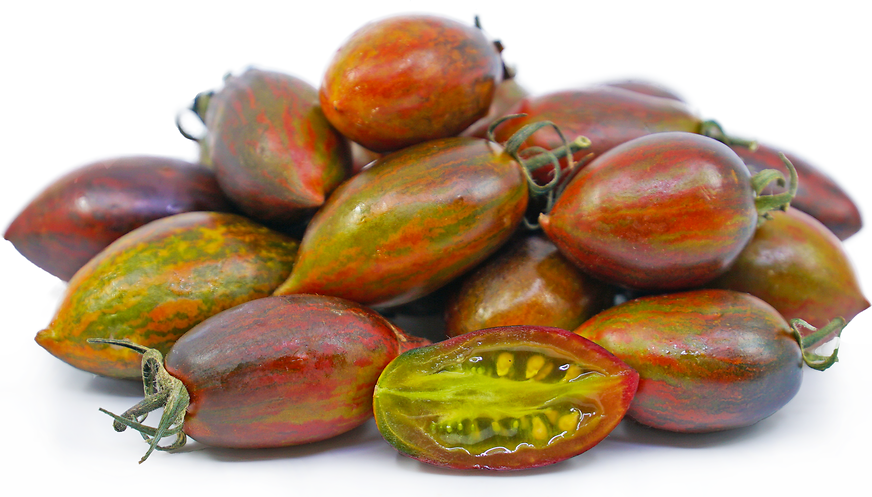


Atomic Grape Tomatoes
Estimated Inventory, 2 lb : 0
Description/Taste
Atomic grape tomatoes are small to medium fruits, averaging 2 to 7 centimeters in length, and have an elongated, oval shape with curved to slightly pointed ends. The fruits grow in clusters on wispy green vines and are green when young, developing dark purple stripes with orange, red, and yellow streaking with maturity. It is important to note that the skin coloring will vary greatly, depending on the climate and growing environment, and cooler weather regions will produce tomatoes with more purple and green hues. The skin is smooth, glossy, and semi-thick, developing a chewy consistency. Underneath the surface, the flesh is dense, aqueous, and multi-colored with green, red, and yellow hues, encasing small chambers filled with tiny seeds suspended in a liquid. Atomic grape tomatoes have a crisp texture, softening slightly with maturity, and develop a complex sweet-tart flavoring mixed with acidic, earthy, vegetal, and savory flavors.
Seasons/Availability
Atomic grape tomatoes are available in the fall through early winter.
Current Facts
Atomic grape tomatoes, botanically classified as Solanum lycopersicum, are a mid to late season variety belonging to the Solanaceae or nightshade family. The small fruits are categorized as a grape tomato and were introduced commercially in the United States in the early 21st century. Atomic grape tomatoes are also known as Brad’s Atomic Grape tomatoes, Atomic tomatoes, and are colorfully nicknamed by some growers as Acid Trip tomatoes. The variety is highly favored for its multi-colored, striped skin, complex flavoring, and all-purpose nature, utilized in both fresh and cooked applications. Atomic grape tomatoes are cultivated on a small scale through specialty growers as a gourmet variety for chefs and farmer’s markets. The cultivar is also valued among tomato enthusiasts for home gardens, selected for its high productivity, delicate foliage, and the fruit’s ability to hold well on the vine, providing an extended harvest.
Nutritional Value
Atomic grape tomatoes are an excellent source of vitamins A and C, antioxidants that strengthen the immune system, boost collagen production within the skin, and reduce inflammation. The tomatoes are also a good source of lycopene, a natural pigment that contributes antioxidant-like properties to protect the body against external environmental aggressors.
Applications
Atomic grape tomatoes have a complex, sweet, and acidic flavor that is best suited for both raw and cooked applications, including roasting, simmering, and baking. The grape tomatoes can be sliced in half and consumed straight, out-of-hand, or they can be chopped into salsa, tossed into salads, used as a topping on tacos, or cut and used as an edible garnish over grain bowls and roasted meats. Atomic grape tomatoes can also be blended into a juice and used as a twist on the classic bloody Mary, or they can be pureed into gazpacho. In addition to fresh preparations, Atomic grape tomatoes can be simmered into sauces, soups, and stews, baked into tarts, or roasted and mixed into pasta. It is important to note that roasting the tomatoes may develop more robust tart flavors within the flesh. Atomic grape tomatoes can be utilized in most recipes calling for common tomatoes. The multi-colored tomatoes pair well with herbs such as thyme, cilantro, basil, oregano, and mint, cheeses such as burrata, mozzarella, feta, and parmesan, meats such as poultry, turkey, beef, and fish, eggplant, dark leafy greens, zucchini, potatoes, and squash. Whole Atomic grape tomatoes will keep 7 to 10 days when stored in a cool, dry, and dark location.
Ethnic/Cultural Info
Atomic grape tomatoes were awarded “Best in Show” at the 2017 National Heirloom Expo, held in Santa Rosa, California. The annual exhibition features over 300 vendors, 150 exhibits, and 100 speakers who discuss seed saving, gardening, breeding, cooking, and best sustainable farming practices with attending guests. The National Heirloom Expo places emphasis on organic farming and the importance of pure, heirloom seed saving. The event was created by Jere Gettle, founder of the Petaluma Seed Bank, in 2011 and is a non-profit exhibition to promote continued innovation in agriculture. The National Heirloom Expo also features live musical competitions, gardening demonstrations, and art pieces constructed from raw produce. Over 20,000 visitors attended the weekend show in 2017, and one of the most popular events was the tomato awards. During the contest, a panel of judges was selected to sample and award outstanding tomato varieties featured at the show. Atomic grape tomatoes received the “Best in Show” award, which was one of the highest honors, recognizing the variety’s quality flavor, appearance, and texture.
Geography/History
Atomic grape tomatoes were developed by breeder Brad Gates at Wild Boar Farms near Napa Valley, California. Gates is known among tomato growers as the “Willy Wonka” of tomato breeding and meticulously performs natural, open-pollination crosses to create new varieties with increased flavor and visual appeal. Gates specializes in multi-colored and striped varieties, such as Atomic grape tomatoes, and grows hundreds of tomato cultivars annually on his four-acre farm. Atomic grape tomatoes were released in the early 21st century and gained national recognition when they were awarded “Best in Show” at the National Heirloom Expo in 2017. After their increased notoriety, Baker Creek Heirloom Seeds partnered with Gates to launch a marketing campaign to promote the variety. Today Atomic grape tomatoes are considered to be one of Baker Creek Heirloom Seed’s most popular tomato cultivars. Atomic grape tomatoes are grown through select growers and are sold through farmer’s markets and specialty grocers to chefs and foodies. The Atomic grape tomatoes featured in the photograph above were grown through Girl & Dug Farm in San Diego, California.
Recipe Ideas
Recipes that include Atomic Grape Tomatoes. One














